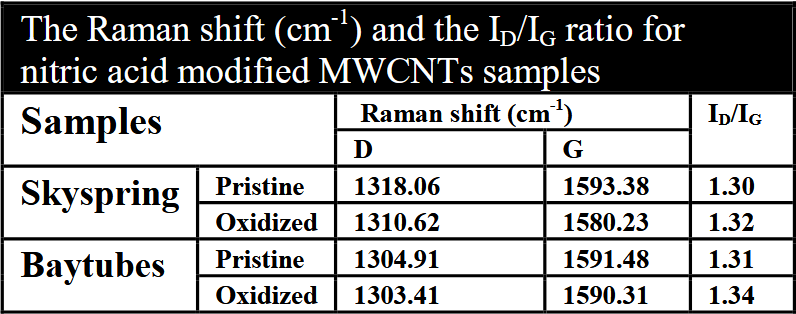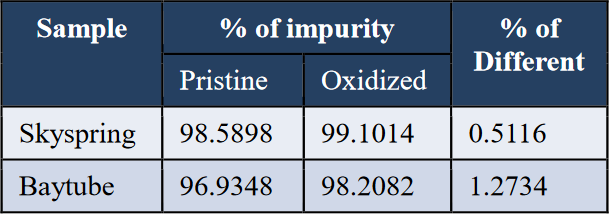NMIM Publications
Carbon Nanotubes

Expired
/ Title
Functionalization by Acidic Treatment in The Purification of Multiwalled Carbon Nanotubes (MWCNTs)
/ Authors
Mohamad Fauzi Ahmad

/ Introduction
The chemical and thermal stabilities, electronic properties, high tensile strength and ultra-light weight are the main features of multi-walled carbon nanotubes (MWCNTs). MWCNTs normally come with purity degree of only less 95%. The purity can be increased by removing the particles of carbonaceous materials (amorphous carbon particles, fullerenes and nanocrystallinepolyaromatic shells) and metal catalysts (generally compounded by Co, Ni or Fe) using refluxing process.
Comparative studies of two multi-walled carbon nanotubes (MWCNT) from different manufacturers were reported in this paper. The purification and
functionalization of commercial multi-wall carbon nanotubes were investigated. MWCNTs were treated with boiling concentrated HNO3 under a reflux condenser for 2 hours at 100 °C in order to purify and oxidize the raw material. The oxidized MWCNTs were rinsed with de-ionized water until the filtrate pH stabilized. Measurement technique used was by applying the thermogravimetric analysis (TGA) for thermal analysis decomposition products and at the same time, the chemical shifted in MWCNTs can be determined by using Raman Spectroscopy.
/ Results and Discussion
Different MWCNTs were analysed using Raman Spectroscopy and Thermogravimetric analyser (TGA). Figure 1 and Table 1 show the Raman spectra for Skyspring and Baytubes.
Figure 1 shows the Raman band of defect (D) & graphitic (G) structure of samples.
Table 2: The TGA analysis result on the left shows the % of impurity for Skspring and Baytubes, before & after acid treatment.
The intensity ratio, ID/IG of both samples was slightly changed after acid treatment and it was demonstrated by the formation of structural defects on the MWCNTs as shown in Table 1.
For both Figure 1 and Table 1, Raman Spectra of Pristine and Oxidized for MWCNT Skyspring and Baytubes were slightly moved.
Based on Table 2, it shows that the purity of MWCNT is slightly increased after purification process. The purity of MWCNT had been improved due to purification process.
TGA analysis also proved that the acid treatment of Oxidized Baytube sample has strongly enhanced the percentage of purity as compared to Oxidized Skyspring sample.
/ Conclusions
Functionalization of MWCNTs has been achieved via acidic treatment. Two different types of MWCNTs from different sources were studied. Raman spectra showed that the D- and G band were shifted in Oxidized Baytube and vice versa for Oxidized Skyspring. TGA
analysis showed the acid treatment of Oxidized Baytube sample eliminated the metal catalyst as compared to Oxidized Skyspring sample which was not changed after the treatment. For both analyses, Baytube MWCNTs are more stable compared to Skyspring MWCNTs.
Advanced Materials Research Vol. 685 (2013) pp 155-158© (2013) Trans Tech Publications, Switzerland doi:10.4028/www.scientific.net/AMR.685.155
National Metrology Institute of Malaysia (NMIM)
Lot PT 4803, Bandar Baru Salak Tinggi
43900 Sepang
Selangor Darul Ehsan
Lot PT 4803, Bandar Baru Salak Tinggi
43900 Sepang
Selangor Darul Ehsan
+6018–2121 833
Corporate Inquiries
Service Inquiries
Complaint & Feedback
Training Course Request




